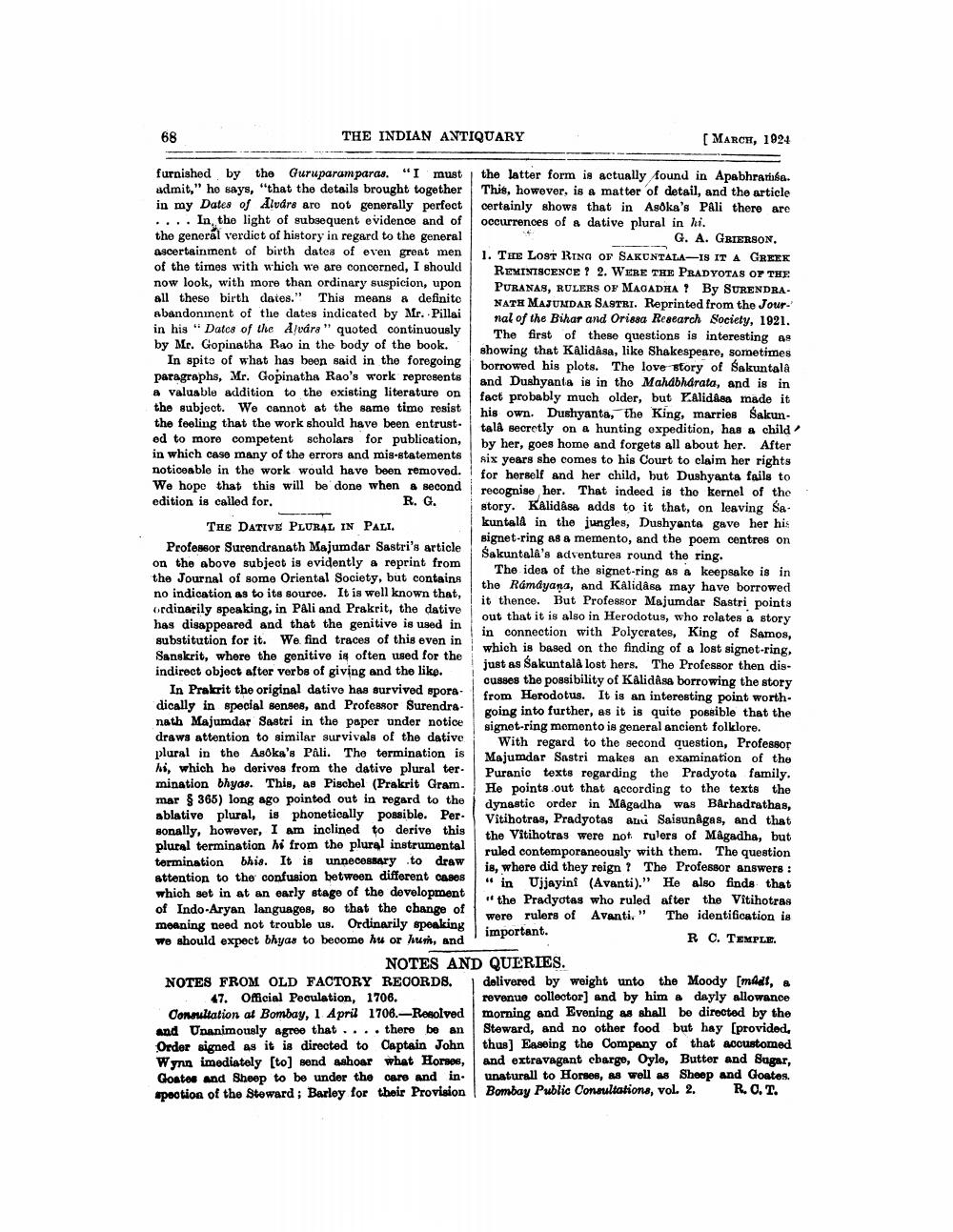________________
THE INDIAN ANTIQUARY
[MARCH, 1924
furnished by the Guruparamparas. “I must the latter form is actually found in Apabhratisa. admit," he says, "that the details brought together This, however, is a matter of detail, and the article in my Dates of Alvárs are not generally perfect certainly shows that in Asöka's PAli there are .... In, the light of subsequent evidence and of occurrences of a dative plural in hi. the generál verdict of history in regard to the general
G. A. GRIERSON. ascertainment of birth dates of even great men 1. THE LOST RING OF SAKUNTALA-IS IT A GREEK of the times with which we are concerned, I should
REMINISCENCE ? 2. WERE THE PRADYOTAS OF THE now look, with more than ordinary suspicion, upon
PURANAS, RULERS OF MAGADHA ? By SURENDRA all these birth dates." This means a definite
NATH MAJUMDAR SASTRI. Reprinted from the Jourabandoninent of the dates indicated by Mr. Pillai
nal of the Bihar and Orissa Research Society, 1921. in his "Dates of the Alvara" quoted continuously
The first of these questions is interesting a by Mr. Gopinatha Rao in the body of the book.
showing that Kalidasa, like Shakespeare, sometimes In spite of what has been said in the foregoing borrowed his plots.
horrowed
The love story of Sakuntala paragraphs, Mr. Gopinatha Rao's work represents
and Dushyanta is in the Mahabharata, and is in a valuable addition to the existing literature on fact probably much older, but F.Alidasa made it the subject. We cannot at the same time resist
his own. Dushyanta, the King, marries Sakunthe feeling that the work should have been entrust.
talA secretly on a hunting expedition, has a child od to more competent scholars for publication,
by her, goes home and forgets all about her. After in which case many of the errors and mis-statements
six years she comes to his Court to claim her rights noticeable in the work would have been removed.
for herself and her child, but Dushyanta fails to We hope that this will be done when & second
recognise her. That indeed is the kernel of the edition is called for.
R. G.
story. Kalidasa adds to it that, on leaving Sa. THE DATIVE PLURAL IN PALI.
kuntala in the jungles, Dushyanta gave her his
signet-ring as a memento, and the poem centres on Professor Surendranath Majumdar Sastri's article
Sakuntala's adventures round the ring. on the above subject is evidently a reprint from
The idea of the signet-ring as a keepsake is in the Journal of some Oriental Society, but contains
the Ramayana, and Kalidase may have borrowed no indication as to its source. It is well known that,
it thence. But Professor Majumdar Sastri points ordinarily speaking, in PAli and Prakrit, the dative
out that it is also in Herodotus, who rolates a story has disappeared and that the genitive is used in
in connection with Polycrates, King of Samos, substitution for it. We find traces of this even in
which is based on the finding of a lost signet-ring, Sanskrit, where the genitive is often used for the
just as Sakuntalê lost hers. The Professor then disindirect object after verbs of giving and the like.
cusses the possibility of Kalidasa borrowing the story In Prakrit the original dativo has survived spora
1 from Herodotus. It is an interesting point worthdically in special senses, and Professor Surendra
going into further, as it is quite possible that the nath Majumdar Sastri in the paper under notice signet-ring momonto is general ancient folklore. draws attention to similar survivals of the dative
i With regard to the second question, Professor plural in the Asoka's Pali. The termination is Majumdar Sastri makes an examination of the hi, which he derives from the dative plural ter. Puranic texts regarding the Pradyota family. mination bhvas. This, & Pischel (Prakrit Gram. He points out that according to the texts the mar $ 365) long ago pointed out in regard to the dynastic order in Magadha was Barhadrathas, ablative plural, is phonetically possible. Per. Vitihotras, Pradyotas anu Saisunågas, and that sonally, however, I am inclined to derivo this the Vitihotras were not rulers of Magadha, but plural termination hi from the plural instrumental
ruled contemporaneously with them. The question termination bhis. It is unnecessary to draw
is, where did they reign ? The Professor answers : attention to the confusion between different cases
" in Ujjayini (Avanti)." He also finds that which set in at an early stage of the development
the Pradyotas who ruled after the Vitihotras of Indo-Aryan languages, so that the change of
were rulers of Avanti." The identification is meaning need not trouble us. Ordinarily speaking
important. we should expect bhyas to become hus or hush, and
RC. TEMPLE NOTES AND QUERIES. NOTES FROM OLD FACTORY RECORDS, delivered by weight unto the Moody [maat, & 47. Official Peculation, 1706.
revenue collector) and by him a dayly allowance Consultation at Bombay, 1 April 1706.-Resolved morning and Evening we shall be directed by the and Unanimously agree that .... there be an Steward, and no other food but hay [provided, Order signed as it is directed to Captain John thus) Easing the Company of that accustomed Wynn imediately [to) send ashoar what Horses, and extravagant cbargo, Oyle, Butter and Sugar, Gostos and Sheep to be under the core and in unaturall to Horses, as well as Sheep and Goatos. spection of the Steward; Barley for their Provision Bombay Public Consultations, vol. 2. R.O.T.




